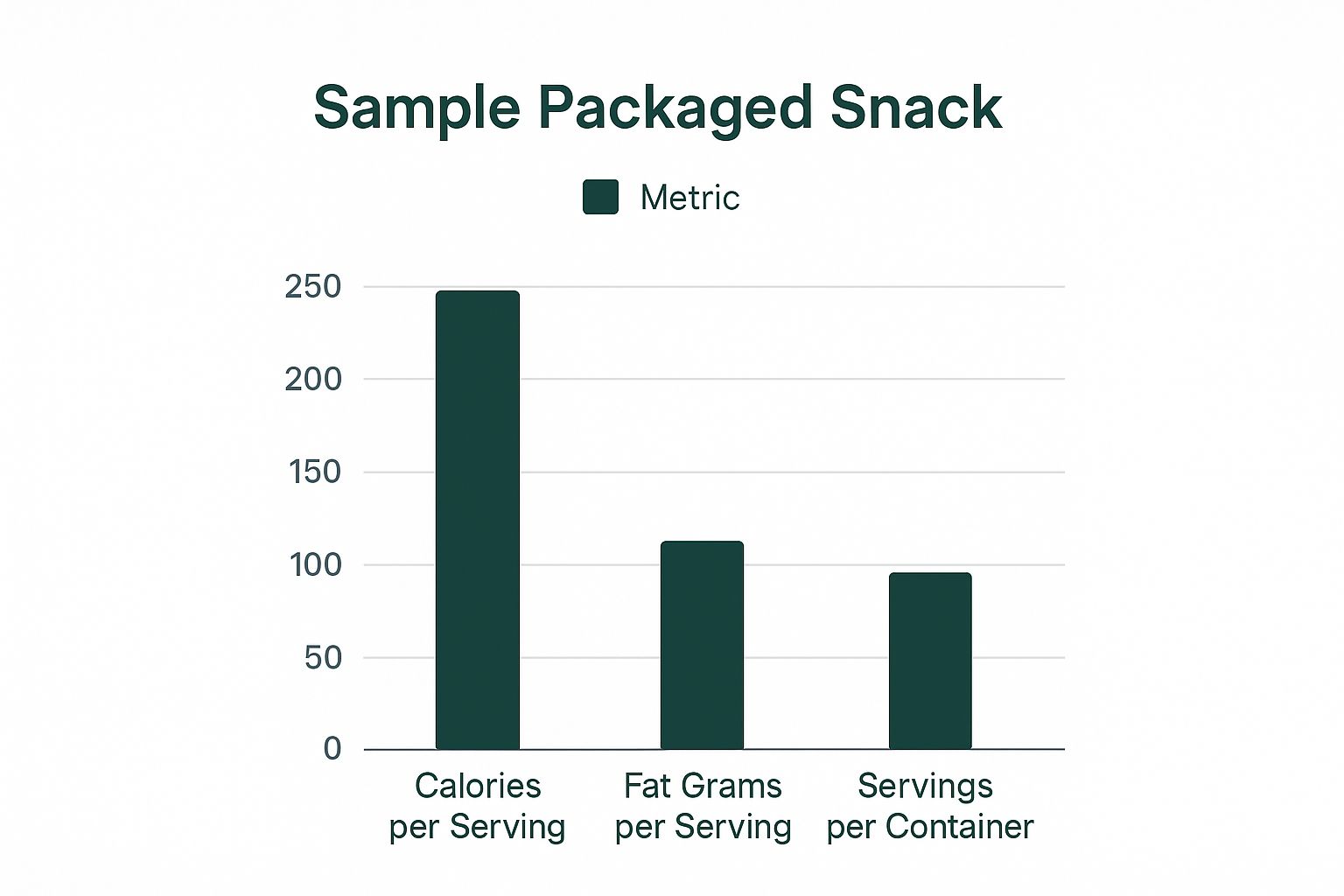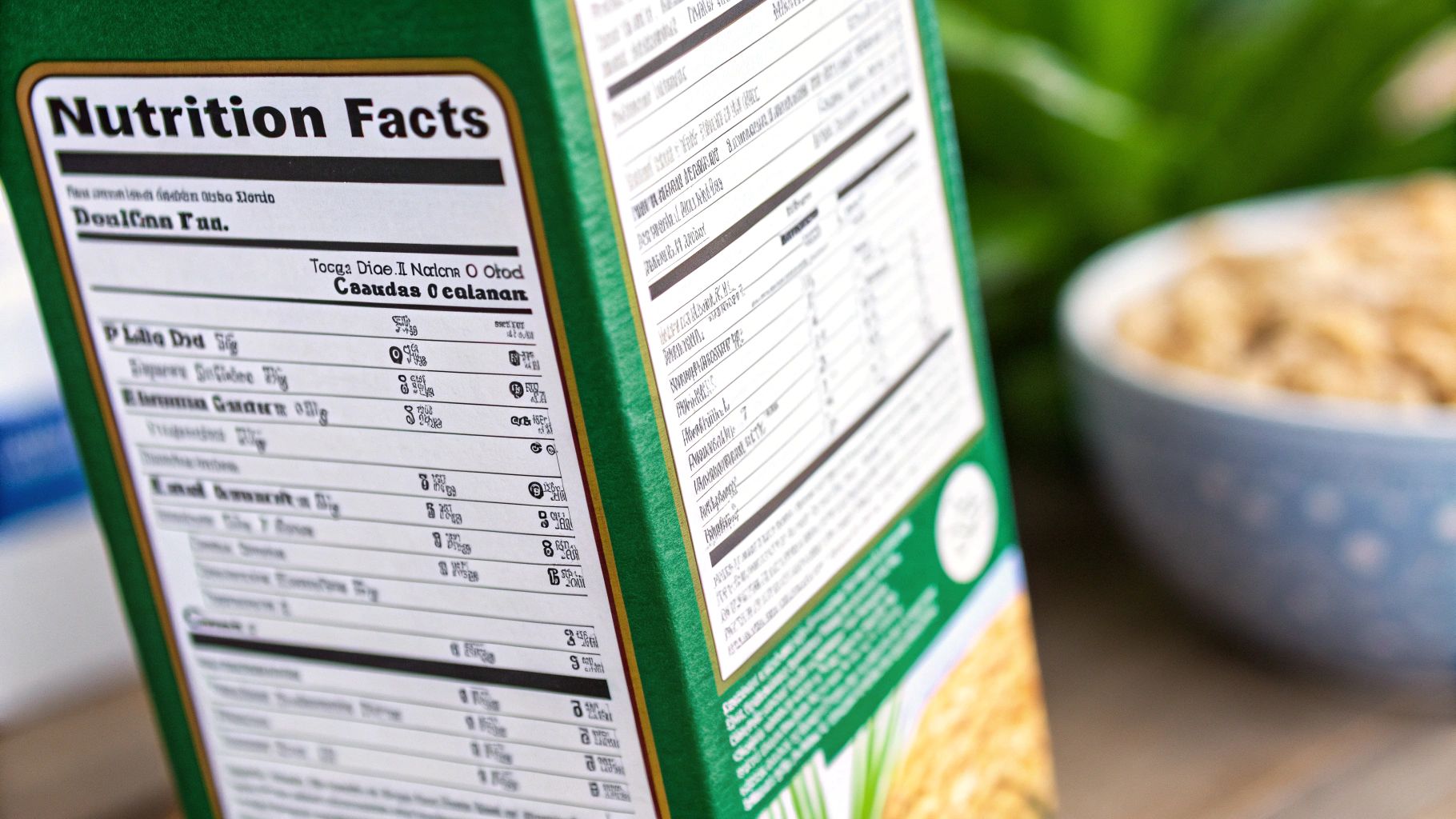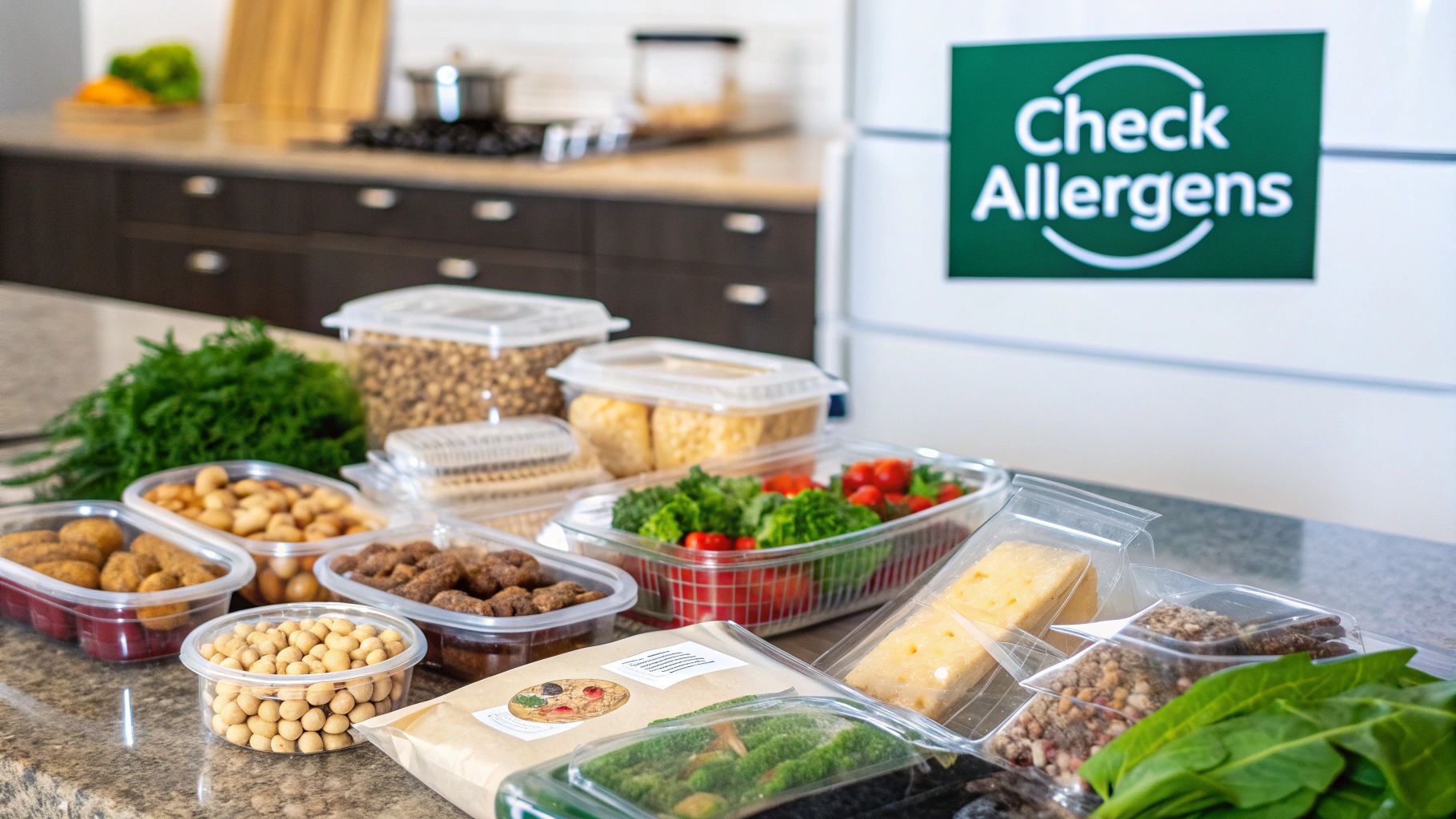How to Read Ingredient Labels Like a Pro
Tired of confusing food packaging? Learn how to read ingredient labels to easily decode what's really in your food and make healthier, informed choices.
Ready to Simplify Your Meal Planning?
Get personalized meal plans and grocery lists automatically matched to your macro targets.

How to Read Ingredient Labels Like a Pro
Ever feel like you need a chemistry degree to understand what’s in your morning cereal? You're not alone. Welcome to your official decoder ring for the grocery aisle—we're about to turn that label confusion into pure, unadulterated confidence.
Let's get the biggest "secret" out of the way first. It all boils down to one simple rule: ingredients are listed by weight, from the most to the least. The first couple of ingredients? They’re the main event, making up the bulk of what you’re about to eat.
Why Reading Labels Is Your Grocery Store Superpower

Mastering the art of reading an ingredient list is one of the single best things you can do for your health. Seriously. This isn't about chasing some impossible standard of "perfect" eating; it’s about being informed and taking back control. Think of it as a superpower that lets you see right through the flashy marketing on the front of the box.
The Real Impact of Label Reading
This skill is more than just a party trick—it has a massive impact on your day-to-day habits and your health down the road. Once you know what you’re looking for, you can start making smarter choices without even thinking about it.
- Dodge Sneaky Sugars: You'll become a pro at spotting the 50+ names for sugar that food companies use to hide it in plain sight.
- Spot Hidden Allergens: No more guesswork. You can confidently pick products that won't ruin your day (or worse).
- Make Healthier Choices on the Fly: Quickly compare two brands of pasta sauce and instantly know which one isn't loaded with junk.
And this isn't just a hunch; the science backs it up. Research consistently shows that people who read food labels make better dietary choices. One major analysis found that label-readers slashed their calorie intake by 6.6% and their total fat by a whopping 10.6%. You can dive into the full study on how labels impact consumer choices if you want to see the numbers for yourself.
By simply flipping over the box, you turn your shopping trip from a wild guessing game into an intentional, empowering act. It’s the first step toward building a pantry that actually nourishes you.
The Golden Rule of Reading Ingredient Lists
Alright, let's get into the one trick that will change how you grocery shop forever. It's so simple, yet so powerful: ingredients are listed by weight, from most to least. That's it. That's the secret.
This single, legally-mandated rule is your x-ray vision for seeing what a product is really made of, cutting right through all the flashy marketing on the front. If you see sugar, or one of its sneaky cousins, in the top three ingredients of that "all-natural" granola bar, you're essentially holding a candy bar. No matter what the beautiful packaging says.
Think about it next time you grab a loaf of bread. Does the first ingredient say "whole wheat flour"? Fantastic, you've got the good stuff. But if it just says "wheat flour" or "enriched flour," you're looking at a refined-grain product that's missing a lot of its original nutrients. The order never lies.
The Great Sugar Shell Game
Now, food companies know you're getting wise to this. They know you're scanning for "sugar" near the top of the list. So, they’ve gotten clever. Insanely clever. To keep any single sweetener from being the #1 ingredient, they use a whole bunch of different ones in smaller amounts.
Instead of one big dose of high-fructose corn syrup, they'll use a little of that, plus a sprinkle of:
- Dextrose
- Evaporated Cane Juice
- Maltodextrin
- Brown Rice Syrup
Suddenly, you've got four or five different types of sugar scattered down the list. But if you were to scoop them all out and weigh them together? Bam. Sugar becomes the main ingredient. It’s a classic move you'll see in everything from salad dressings to "healthy" yogurts.
My Two Cents: Treat that ingredient list like the gospel truth. It's regulated, it's non-negotiable, and it's your best defense against clever marketing. The order tells you the real story, every single time.
To help you become a sugar detective, I've put together a little cheat sheet. Manufacturers use a dizzying number of names for sugar and artificial sweeteners, and spotting them is half the battle.
Common Hidden Sugars and Sneaky Names
| Common Name | Also Known As... | Category |
| High-Fructose Corn Syrup | Glucose-fructose syrup, isoglucose | Added Sugar |
| Sucrose | Table sugar, beet sugar, cane sugar | Added Sugar |
| Dextrose | Corn sugar, glucose, grape sugar | Added Sugar |
| Maltodextrin | Corn syrup solids, modified corn starch | Processed Sweetener |
| Agave Nectar | Agave syrup | "Natural" Sugar |
| Aspartame | NutraSweet, Equal | Artificial Sweetener |
| Sucralose | Splenda | Artificial Sweetener |
Keep this list handy. The more of these names you recognize, the harder it will be for food companies to pull a fast one on you.
This chart is a perfect example of why paying attention matters. It breaks down the nutrition facts for a pretty standard snack.

See that "2 servings per container"? That’s the other part of the game. It’s easy to look at the numbers and think, "250 calories, 8g of fat, not too bad." But let's be honest, who eats half a bag of chips? If you finish the whole thing—which most of us do—you're actually downing 500 calories and 16g of fat. The numbers add up fast.
Cracking the Code on the Nutrition Facts Panel

Alright, you’ve wrestled with the ingredient list. Now, let’s flip that package over and look at its trusty sidekick: the Nutrition Facts panel. This is where the story gets told in numbers, and trust me, it's a story worth reading.
And you're not the only one peeking at it. Nearly 80% of American adults check this panel when shopping, a huge leap from just 62% back in 2005. It's clear people are paying more attention to what's in their food. You can get the full scoop on how consumer habits have changed on ers.usda.gov.
Think of this panel as the cheat sheet that translates all those ingredients into cold, hard data about what you’re actually putting into your body.
First Things First: Serving Size
Before your eyes wander anywhere else, lock them onto the serving size. This is, without a doubt, the number one spot where food labels get tricky. That little "personal" bag of chips? Look closer. It probably contains two or even three servings.
It's an easy mistake to make, but missing it means you could be doubling or tripling the calories, sugar, and sodium you think you're consuming. The most important question to ask yourself is, "Am I really only going to eat this much?" Be honest!
Pro Tip: If you know you're going to polish off the whole container (we've all been there), do the math right then and there. Multiply the calories and other key numbers by the "servings per container" to see the real total. No more post-snack surprises.
Your Shortcut: The Percent Daily Value
Now, glance over to the right-hand column and find the Percent Daily Value (%DV). This little percentage is your secret weapon for making quick, informed decisions in the grocery aisle. It puts everything into context.
Here’s the simple rule of thumb that I live by:
- 5% DV or less of a nutrient is low. This is your target for things you want to keep in check, like sodium, saturated fat, and especially those pesky added sugars.
- 20% DV or more of a nutrient is high. This is what you want to see for the good stuff—think fiber, vitamin D, calcium, and potassium.
Using the %DV is a game-changer. You can instantly compare two brands of cereal and see which one packs more fiber or less sugar, all without having to get bogged down in grams and milligrams. It's the ultimate shortcut to making a smarter choice, faster.
How to Spot Allergens and Unwanted Additives
For a lot of us, a quick scan of the ingredient list isn't just about being healthy—it's about staying safe. Trying to dodge potential allergens and additives you'd rather not eat can feel like navigating a minefield, but knowing what to look for can turn that stress into confidence.
Thankfully, federal law gives us a major leg up. The Food Allergen Labeling and Consumer Protection Act (FALCPA) mandates that the nine major food allergens be clearly identified in plain English.
These are the big ones to watch for:
- Milk
- Eggs
- Fish
- Shellfish
- Tree nuts
- Peanuts
- Wheat
- Soybeans
- Sesame
You’ll usually see them highlighted in a bolded "Contains" statement right below the ingredient list. This makes a quick safety check incredibly straightforward. For instance, if a product has cashews and soy, the label will spell it out: "Contains Tree Nuts (Cashews), Soy."
This screenshot from Wikipedia is a great visual reminder of common food allergens and what they can do.
The image really drives home how different reactions can be, which is exactly why a careful label check is non-negotiable for anyone with sensitivities.
Looking Beyond the Big Nine
But what about stuff you just want to avoid for other reasons? I'm talking about things like artificial colors (FD&C Red No. 40), preservatives like BHT, or flavor enhancers like MSG (monosodium glutamate).
These ingredients won't get their own special "Contains" statement. To find them, you have to put on your detective hat and scan the full ingredient list yourself.
One of the sneakiest culprits is the term "natural flavors." It sounds harmless, right? But it’s really just a vague catch-all for anything derived from a natural source. If a natural flavor happens to contain one of the top nine allergens (like a flavor derived from milk), the law says it has to be declared. But other potential irritants could easily be hiding in there.
Pro Tip: Never trust front-of-package claims like "school safe" or "allergy-friendly" over the actual ingredient list. Those are marketing terms, not regulated guarantees. They don't mean a product is free from the specific allergen you or your family needs to avoid.
Seeing Through Health Claims and Marketing Hype

Welcome to the front of the box—the food industry’s personal billboard. It’s plastered with feel-good buzzwords and dazzling claims designed to catch your eye and convince you you’re making a healthy choice. But let's be real: this is marketing, not science.
Your best weapon against this marketing wizardry is learning to flip that package over and get to the truth.
Terms like "All-Natural," "Made with Real Fruit," and "Multigrain" sound fantastic, don't they? The problem is, they often mean very little. "Multigrain" just means the product uses more than one type of grain. It doesn't mean they're the good kind—whole grains. For that confirmation, you have to hit the ingredients list.
And don't even get me started on the word "natural." It’s a marketer’s dream because the legal definition is incredibly vague. A product can be loaded with high-fructose corn syrup and still slap "natural" on the label. Why? Because the syrup came from corn, and corn is a plant. See the game?
Your Hype-Detecting Checklist
Before you let a pretty picture of a sun-drenched wheat field sway you, just flip the package over. The ingredient list never lies.
A classic trick is the kids' "fruit" snack. The box might scream "Made with Real Fruit" in bright, happy letters. But a quick peek at the ingredients often shows corn syrup as the number one ingredient. That "real fruit" is usually a tiny amount of fruit concentrate—a sugary, fiber-stripped shadow of its former self—way down the list.
Here's the golden rule I live by in the grocery aisle: The front of the package tells you what they want you to believe. The ingredient list tells you the truth. Always, always trust the ingredient list.
Next time you see a flashy claim, run it through this quick mental checklist:
- How specific is it? A claim like "Good source of fiber" is actually regulated by the FDA and has a specific meaning. "Wholesome goodness," on the other hand, is pure marketing fluff with zero substance.
- Where's the good stuff? If a cereal box boasts "Made with Whole Grains," check to see if a whole grain is the first or second ingredient. If it’s buried at the bottom of a long list of sugars and refined flours, you've been had.
- What does that really mean? Terms like "Lightly sweetened" aren't regulated. It's a subjective phrase that could still mean the product is packed with sugar.
Thinking this way turns you from just another shopper into a savvy food detective. Game on.
Answering Your Burning Label Questions
Okay, so you've got the basics down. You know to scan the first few ingredients and check the nutrition panel. But then you run into something that makes you stop and go, "Wait, what does that mean?" It happens to everyone. Let's clear up some of the most common curveballs you'll find on an ingredient list.
One of the sneakiest culprits is the whole "non-dairy" versus "dairy-free" thing. You’d assume they’re interchangeable, but you'd be wrong. Shockingly, a product labeled "non-dairy" is legally allowed to contain casein, which is a milk protein. You see this a lot on things like coffee creamers, so if you have a real-deal milk allergy, you have to read the full ingredient list.
What’s the Deal with "Natural Flavors"?
Ah, "natural flavors." This one is a real head-scratcher. It’s a super vague, catch-all term for any flavor that comes from a natural source, whether that’s a plant or an animal. While it sounds perfectly innocent, it can be a trojan horse for dozens of different compounds.
The good news? If a "natural flavor" contains one of the top nine allergens (like milk or soy), the company is required to declare it. The bad news is that other things you might be sensitive to could still be hiding in there. It just goes to show how ridiculously complex these labels can be. In fact, one analysis found that nearly 75% of ingredient lists require at least a 9th-grade reading level to comprehend. You can dive deeper into the complexity of food labels if you're feeling nerdy.
Here's my personal take: if a product is leaning heavily on "natural flavors" instead of just using, you know, actual spices or fruit, I get a little skeptical. It’s often a sign that the food is pretty heavily processed.
How Seriously Should I Take Those "May Contain" Warnings?
You’ve seen them a million times. The little disclaimers at the bottom of the list:
- "May contain wheat..."
- "Processed in a facility that also handles peanuts..."
These are precautionary allergen labels, and here’s the kicker: they're totally voluntary. There's no law or standard for how and when they get used. One company might slap it on for the slightest possibility of cross-contact, while another might not bother, even with a higher risk.
For anyone with a life-threatening allergy, the only safe bet is to listen to your doctor's advice on these products. It’s a perfect example of why learning to read labels isn't just about what's on the list, but also understanding what's in the gray area.
---
Tired of playing detective in the grocery aisle? Meal Flow AI can create personalized meal plans that fit your exact needs and even send the shopping list right to Instacart. Take the guesswork out of eating well and let us handle the planning. Check it out at https://mealflow.ai today